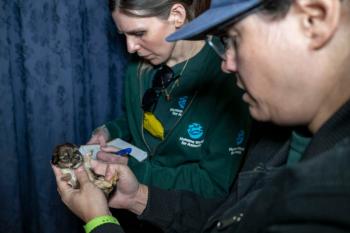
Veterinarian recounts Zanesville's tragic killing of 49 exotic, wild animals
Zanesville, Ohio - "One of the captains ... said to me, 'We all knew this was going to end badly, we just didn't know how badly it would (end).'"
ZANESVILLE, OHIO — "One of the captains ... said to me, 'We all knew this was going to end badly, we just didn't know how badly it would (end).' "
That somber message was delivered by veterinarian Barbara Wolfe of The Wilds in Cumberland, Ohio, who ultimately oversaw law enforcement's killing of 49 exotic and dangerous wild animals after they were let loose by an owner who then fatally shot himself.
On Oct. 18, Terry Thompson, a convicted felon in Zanesville, released 56 of the wild and exotic animals he kept on his 46-acre preserve located about 50 miles east of Columbus before committing suicide. The event triggered a full-scale effort by law enforcement, veterinarians and Columbus Zoo's Director Emeritus Jack Hanna to contain the animals. Simultaneously, there was an outcry from veterinary and humane groups to strengthen Ohio's exotic animal ownership laws. New legislation is already in progress as a result of the Zanesville incident.
But before that would happen, 49 of the animals—including 17 lions and 18 rare Bengal tigers—were ultimately killed by authorities who, with the help of veterinarians from the Columbus Zoo and The Wilds, determined that trying to tranquilize the animals would be too dangerous.
Wolfe says her team at The Wilds, a 10,000-acre conservation center in Cumberland, Ohio, has been working with the Muskingham County Sheriff's Office for several years trying to find ways to remove the animals from "deplorable" conditions at Thompson's property.
"The conditions were not suitable but there were not strict enough laws in Ohio to bring an animal cruelty charge against them," Wolfe says.
Since the property owner provided the animals food and water and kept them caged, Wolfe says, there was little law enforcement could do to intervene prior to Oct. 18. Wolfe credits the local sheriff's office with containing the situation, calling them "heroes" and adding it wasn't an easy situation for anyone.
"There was absolutely no way we could contain 56 large cats," she says.
Only a 4-ft.-tall wire livestock fence surrounded Thompson's property, adds Muskingham County Sheriff Matt Lutz.
"We had officers on foot by the pens, trying to close the pens up. One time, a cat stuck his head out from fenced area that was cut and came out of the cage at the guys," Lutz says. "There were times it was pretty dangerous. ... They just weren't contained enough to able to dart them."
Lutz says officers were called to the compound at 5 p.m. by neighbors who saw a lion, tiger and bear chasing Thompson's herd of horses.
Early efforts to tranquilize the animals proved unsuccessful and dangerous, Wolfe adds.
Armed with a pistol and a tranquilizer gun, Wolfe tried to sedate one large cat hiding in dense brush. She recalls climbing into the bushes to get within 15 feet to dart the animal. The animal didn't respond immediately after the dart hit, she recalls. Within 15 seconds, the cat got up and roared. It had to be put down, Wolfe says.
"I think most veterinarians understand that in not too many circumstances like this could you recover the animals alive," Wolfe says.
After attempts failed to sedate these animals, veterinarians and law enforcement agreed to "shoot to kill" and review the situation in the morning.
Meanwhile, authorities tried to piece together Thompson's motives in releasing the animals and taking his own life.
"In the back of my mind, I always dreamed that Terry would probably be mauled by a bear or one of the cats. He was very trusting of them," Lutz says. "I never dreamed that he would let them loose himself."
Wolfe says the tragedy called on unexpected aspects of her veterinary training, especially when it came to helping the coroner identify some of Thompson's wounds.
"Certainly this man was very attached to his animals and thought he was doing the right thing for them. He could go into enclosures with most of the animals," says Wolfe. "But they were very aggressive animals and very dangerous and posed a huge risk to the general public. I don't think that there's any question that they would have harmed him, as well, even if they had had a relationship with him."
Public interest in this event presented another challenge in responding to the catastrophe, Lutz says. There was wide-scale media attention that drew spectators, some of whom were looking for souvenirs of the tragedy. Deputies stood guard over the animals that were killed, but two or three teenagers were caught trying to throw one of the animals in the trunk of their car. Lutz says that Thompson's widow asked that the animals be buried on the property and, after approvals from the health department and veterinary officials, a Thompson family friend dug a grave, and the animals were placed inside.
Six animals—three leopards, two macaques monkeys and a grizzly bear cub—were contained and rescued and sent to the Columbus Zoo. Fifty to 60 horses remain on the property, Lutz says.
Thompson's widow is attempting to regain possession of the animals being held at the zoo, but an Oct. 27 quarantine order issued by the Ohio Department of Agriculture (ODA) has made that impossible, at least temporarily.
The order prohibits the zoo from releasing the animals to Thompson's widow until the threat of disease can be ruled out. ODA suggests the animals could have been exposed to a number of diseases, including herpes B virus.
The exotic ownership question
Outcries from the shooting resonated from the public after news broke about the Zanesville incident, but numerous groups—including the Ohio Veterinary Medical Association (OVMA), the American Society of the Prevention of Cruelty to Animals (ASPCA) and the Humane Society of the United States (HSUS)—called on state lawmakers to change Ohio law regarding exotic animal ownership.
An emergency order signed by outgoing Ohio Gov. Ted Strickland in January put a 90-day ban in place that prohibited the sale, possession, breeding and transfer of a number of exotic animals. But Gov. John Kasich allowed the temporary ban to expire earlier this year. Within days of the event, Kasich issued a new executive order calling for state agencies to increase inspections and enforce state laws related to animal health, captivity and cruelty. It calls for the Ohio Department of Health, Ohio Department of Natural Resources and the ODA to cooperate in the investigation and inquiry into private places where dangerous wild animals are housed, maintained and owned.
The American Veterinary Medical Association (AVMA) used the tragedy as a reminder for states with less-than-adequate laws on exotic ownership to adopt better regulations on private ownership of wild animals.
Newsletter
From exam room tips to practice management insights, get trusted veterinary news delivered straight to your inbox—subscribe to dvm360.






